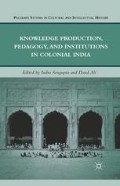Abstract
The successive stages of what has been called the “Oriental renaissance” are well documented. The Orientalists not only translated the major texts of Sanskrit literature but also turned to the material remains of Indian civilization to study the subcontinent’s history, mythology, and religion. If monuments had been arousing curiosity since the sixteenth century, the growth of British rule entailed a more systematic investigation of archaeological remains. Documentation developed significantly from the last decades of the eighteenth century onward, and the first measures of preservation of selected edifices and the creation of museums devoted to Indian objects of art emerged at the dawn of the nineteenth century. The aim of this chapter is to show how the twofold issue of documentation and preservation of material remains provides an interesting example of the potential discrepancy between the production of knowledge and the modalities of its implementation within an institutional context. I will argue that despite developing within the same circles, the focus of antiquarian knowledge and the nature of the restoration works actually carried out proved radically different, thus calling into question the relationship between the production of knowledge and its uses.
Access this chapter
Tax calculation will be finalised at checkout
Purchases are for personal use only
Preview
Unable to display preview. Download preview PDF.
Notes
Walter Ewer, “An Account of the Inscriptions on the Cootub Minar, and on the Ruins in Its Vicinity,” AR 14 (1822): 486–487.
Mildred Archer, Company Drawings in the India Office Library (London: Her Majesty’s Stationery Office, 1972), 194.
See, for instance, Dilip K. Chakrabarti, Archaeology in the Third World: A History of Indian Archaeology since 1947 (New Delhi: D. K. Printworld, 2003), 165.
The major cases deal with the Triplicane and Dharmasthala pagodas. For a detailed analysis of the British interference in temple politics through the example of the Sri Partasarati Svami Temple (Triplicane), cf. Arjun Appadurai, Worship and Conflict under Colonial Rule: A South Indian Case (Cambridge: Cambridge University Press, 1981).
According to Eugene F. Irschick, this project, together with Place’s attempts to revive the temple festivals at Kanchipuram, was aimed at “revitalizing Hindu religious life” and was hence part of the collector’s broader plan to “reorder society in the Jagir.” Eugene F. Irschick, Dialogue and History: Constructing South India, 1795–1895 (Berkeley/Los Angeles: University of California Press, 1994), 79.
Evocation of a glorious past was also perceptible in the eighteenth- and nineteenth-century Mughal architecture. The embellishment of the Delhi shrine of Bakhtiyar Kaki, made in 1717–1718 by Farrukh Siyar, relied on motives of the famous Ajmer dargah of Khwaja Muin-ud-Din. Similarly, the mosque commissioned in 1841–1842 by Hamid Ali Khan bore features used in previous Mughal structures, notably those dating back to Shah Jahan’s reign. Ghalib, who wrote the inscription of the mosque, was later commissioned by Bahadur Shah to write a history of the Mughal house, in which the poet described the reign of Shah Jahan as a golden age. Cf. Catherine B. Asher, “Piety, Religion and the Old Social Order in the Architecture of the Later Mughals and Their Contemporaries,” in Rethinking Early Modern India, ed. Richard B. Barnett (New Delhi: Manohar, 2002), 198–199.
Catherine B. Asher and Cynthia Talbot, India before Europe (New York: Cambridge University Press, 2006), 48.
The following examples of Aurangzeb’s patronage are taken from Catherine B. Asher, Architecture of Mughal India (Cambridge: Cambridge University Press, 1992), 255, 260–262.
Aqil Khan Razi, Waqiat-i-’Alamgiri, ed. Zafar Hasan (Delhi: Mercantile Printing Press, 1946), 45.
Saqi Must’ad Khan, Maasir-i-’Alamgiri, ed. Jadunath Sarkar (Calcutta: Royal Asiatic Society of Bengal, 1947), 315.
Aurangzeb, Ruqa’at-i-’Alamgiri, in Taj Mahal: The Illuminated Tomb, An Anthology of Seventeenth-Century Mughal and European Documentary Sources, ed. W. E. Begley and Z. A. Desai (Cambridge: Aga Khan Program for Islamic Architecture, 1989), 175–176.
Romila Thapar, “Communalism and the Historical Legacy: Some Facets,” in Communalism in India: History, Politics and Culture, ed. K. N. Panikkar (New Delhi: Manohar, 1991), 26.
Cynthia Talbot, “Inscribing the Other, Inscribing the Self: HinduMuslim Identities in Pre-Colonial India,” in India’s Islamic Traditions, 711–1750, ed. Richard M. Eaton (New Delhi: Oxford University Press, 2003), 83–117.
Kate Brittlebank, Tipu Sultan’s Search for Legitimacy: Islam and Kingship in a Hindu Domain (New Delhi: Oxford University Press, 1997), 125–130.
Benefaction enhanced the ruler’s prestige and asserted his dominance: it was part of an ideal of kingship, which influenced rulers and aspiring ones. See, for example, Susan Bayly, Saints, Goddesses and Kings: Muslims and Christians in South Indian Society, 1700–1900 (Cambridge: Cambridge University Press, 1989).
Peter van der Veer, Imperial Encounters: Religion and Modernity in India and Britain (New Delhi: Permanent Black, 2001), 21. Under evangelical pressure, neutrality in religious policy was progressively promoted. The British administration remained, all the same, involved in the management of religious institutions. It can also be mentioned that British payments to temples, rather than being an extension of the indigenous model of royal patronage, were often acting as a compensation for the appropriation of local revenue sources (Appadurai, Worship and Conflict, 141).
Editor information
Copyright information
© 2011 Indra Sengupta and Daud Ali
About this chapter
Cite this chapter
Etter, AJ. (2011). Antiquarian Knowledge and Preservation of Indian Monuments at the Beginning of the Nineteenth Century. In: Sengupta, I., Ali, D. (eds) Knowledge Production, Pedagogy, and Institutions in Colonial India. Palgrave Studies in Cultural and Intellectual History. Palgrave Macmillan, New York. https://doi.org/10.1057/9780230119000_5
Download citation
DOI: https://doi.org/10.1057/9780230119000_5
Publisher Name: Palgrave Macmillan, New York
Print ISBN: 978-1-349-29518-0
Online ISBN: 978-0-230-11900-0
eBook Packages: Palgrave History CollectionHistory (R0)

